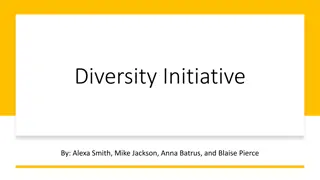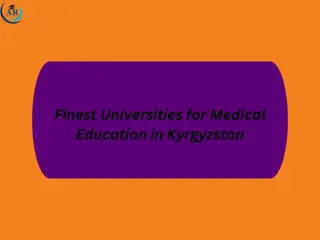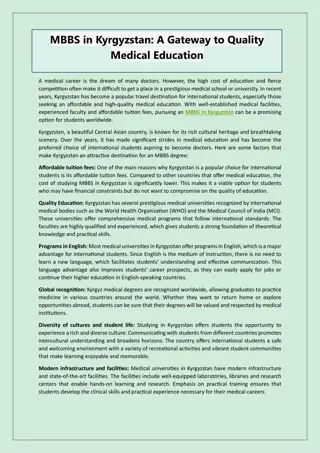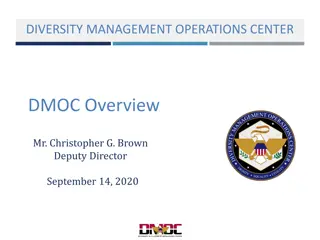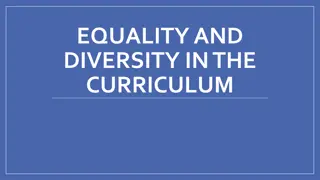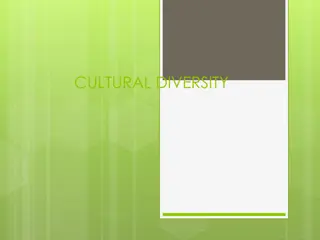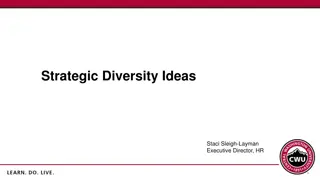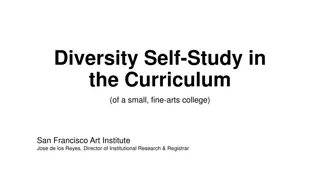Diversity in Medical Education: Insights and Implications
Exploring diversity in medical education, this presentation by Karen Stegers-Jager delves into the selection procedures, demographics of admitted students, and performance outcomes, highlighting the impact of ethnicity and social background. The discussion suggests practical implications for including non-academic criteria in selection processes and using diverse criteria to enhance student diversity.
Uploaded on Sep 18, 2024 | 0 Views
Download Presentation

Please find below an Image/Link to download the presentation.
The content on the website is provided AS IS for your information and personal use only. It may not be sold, licensed, or shared on other websites without obtaining consent from the author. Download presentation by click this link. If you encounter any issues during the download, it is possible that the publisher has removed the file from their server.
E N D
Presentation Transcript
Dealing with diversity in medical education Karen Stegers-Jager Institute of Medical Education Research Rotterdam (iMERR) June 9th2017
Getting in admissions1 1 Stegers-Jager et al Med Educ 2015;1:124-133.
Who gets in? - ethnicity Dutch < Non-Dutch < Sur/Ant & Tur/Mor/Afr Dutch Non-Dutch Dutch < Non-Dutch < Sur/Ant & Tur/Mor/Afr & Asian
Who gets in? social background non 1st gen univ student 1st gen univ student non 1st gen univ student 1st gen univ student non 1st gen univ student < 1st gen univ student
Discussion - Ethnicity and social background independent predictors of admission, but surprising differences academic and non-academic criteria - No differences non-academic criteria self-selection before application? - Poorer performance on cognitive tests non-traditional students - Language skills?/ Cultural aspects?
Practical implications - Include non-academic criteria in selection procedure - Use different selection criteria concurrently and explore impact of weighting on student diversity
Staying in progression and retention1 1 Stegers-Jager et al Med Educ 2012;46:575 85.
Results Performance - Year 1 course completion: Dutch (64%) > Non Dutch (52%) > Sur/Ant (37%), Asian (50%) - Preclinical course completion:Dutch (41%) > Non Dutch (29%) Dutch (41%) > Sur/Ant (19%), Asian (24%) - Good clinical performance: Dutch (88%) > Non Dutch (67%) Dutch (88%) > all 4 groups (54-77%)
Results Performance (adjusted1) - Year 1 course completion: Dutch (64%) > Non Dutch (52%) > Sur/Ant (37%), Asian (50%) - Preclinical course completion:Dutch (41%) > Non Dutch (29%) Dutch (41%) > Sur/Ant (19%), Asian (24%) - Good clinical performance: Dutch (88%) > Non Dutch (67%) Dutch (88%) > all 4 groups (54-77%) 1Adjusted for age, gender, pu-GPA & socio-demographic factors
Discussion - Differences across ethnic minority groups in comparisons to majority students - Greater ethnic disparities in clinical training clinical skills? communication styles? stereotype threat? examiner bias?
Practical implications Preclinical course: - Targeted support Clinical course: - Less subjective grading - Awareness cultural bias
Staying in different types of examinations1 1 Stegers-Jager et al Adv Health Sci Educ 2016;21:1023-1046.
Different types of examinations Written Clinical Theoretical Afbeeldingsresultaat voor workplace based assessment Clinical case A 75-year-old man, heavy smoker Skills
Discussion main findings Differences across ethnic subgroups and between different types of written and clinical exams CPSTs, language test & clinical exams: all 3 non-western groups Block tests & writing skills tests & Western minority: less consistent Age, gender, pu-GPA and socio-demographic variables could explain: YES: differences in theoretical exams (CPSTs & block tests) NO: differences in language, writing & clinical skills exams 1st generation university students only on language tests
Discussion explanations Difference between CPSTs & block tests Nature & required preparation No indication lower level clinical skills Western minority & 1st gen students More subjective grading in clinical training? Underperformance in language, writing & clinical skills exams not explained: Cultural differences in communication styles?
Practical implications Avoid unintended effects of certain types of examinations for certain groups of students consider diversity in both test construction & implementation Offer additional exam-specific support for specific groups e.g. formal meetings to prepare for CPSTs
Take-home message In order to select and retain non-traditional students in the medical education pipeline, medical schools must design assessment strategies and, if necessary, additional targeted support programmes that create a level playing field for a diverse student population More information: k.stegers-jager@erasmusmc.nl
Statements 1. In the Netherlands, we need minority doctors for minority patients 2. Affirmative action for non-traditional applicants is necessary 3. Differences in clinical grades are due to subjective grading 4. Lower clinical grades reduce chances for specialty training 5. Cultural sensitivity should be taught at (medical) school


